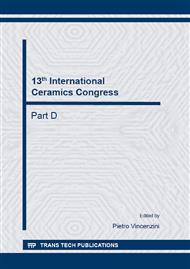[1]
European Union, Directive 2002/95/EC of the European Parliament and of the Council of 27 January 2003 on the restriction of the use of certain hazardous substances in electrical and electronic equipment, Off. J. Eur. Union 46 (L37) (2003) 19–23.
Google Scholar
[2]
H. Birol, D. Damjanovic, N. Setter, Preparation and characterization of KNbO3 ceramics, J. Am. Ceram. Soc. 88 (2005) 1754–1759.
DOI: 10.1111/j.1551-2916.2005.00347.x
Google Scholar
[3]
R. E. Jaeger, L. Egerton, Hot pressing of potassium-sodium niobates, J. Am. Ceram. Soc. 45(1962) 209–213.
DOI: 10.1111/j.1151-2916.1962.tb11127.x
Google Scholar
[4]
C-R. Zhou, X-Y. Liu, Z-W. Li, C-L. Yuan, Effect of substitution of titanium by magnesium and niobium on structure and piezoelectric properties in (Bi1/2Na1/2)TiO3 ceramics, Bull. Mat. Sci. 32 (2009) 99–102.
DOI: 10.1007/s12034-009-0015-y
Google Scholar
[5]
Y. Saito, H. Takao, T. Tani, T. Nonoyama, K. Takatori, T. Homma, T. Nagaya, M. Nakamura, Lead-free piezoceramics, Nature 432 (2004) 84–87.
DOI: 10.1038/nature03028
Google Scholar
[6]
Y.H. Lee, J.H. Cho, B.I. Kim, D.K. Choi, Piezoelectric properties and densification based on control of volatile mass of potassium and sodium in (K0. 5Na0. 5)NbO3 ceramics, Jpn. J. Appl. Phys. 47 (2008) 4620–4622.
DOI: 10.1143/jjap.47.4620
Google Scholar
[7]
M. Bah, F. Giovannelli, F. Schoenstein, G. Feuillard, E. Le–Clezio, I. Monot–Laffez, High electromechanical performance with spark plasma sintering of undoped K0. 5Na0. 5NbO3 ceramics, Ceram. Int. 40 (2014) 7473–7480.
DOI: 10.1016/j.ceramint.2013.12.097
Google Scholar
[8]
S. Grasso, Y. Sakka, G. Maizza, Electric current activated/assisted sintering (ECAS): a review of patents 1906–2008, Sci. Technol. Adv. Mater. 10 (2009) 053001-1–053001-24.
DOI: 10.1088/1468-6996/10/5/053001
Google Scholar
[9]
B. Jaffe, W. R. Cook, H. Jaffe, Piezoelectric ceramics, Academic press, London, (1971).
Google Scholar
[10]
M. Prakasam, P. Veber, O. Viraphong, L. Etienne, M. Lahaye, S. Pechev, E. lebraud, K. Shimamura, M. Maglione, Growth and characterizations of lead-free ferroelectric KNN-based crystals, C. R. Phys. 14 (2013) 133–140.
DOI: 10.1016/j.crhy.2012.10.002
Google Scholar
[11]
K. Chen, G. Xu, D. Yang, X. Wang, J. Li, Dielectric and piezoelectric properties of lead-free 0. 95(K0. 5Na0. 5)NbO3 – 0. 05LiNbO3 crystals grown by the Bridgman method, J. Appl. Phys. 101 (2007) 044103-1–044103-4.
DOI: 10.1063/1.2562464
Google Scholar
[12]
R. Krimholtz, D.A. Leedom, G.L. Matthaei, New equivalent circuits for elementary piezoelectric transducers, Electron. Lett. 6 (1970) 398–399.
DOI: 10.1049/el:19700280
Google Scholar
[13]
L.P. Tran-Huu-Hue, F. Levassort, N. Felix, D. Damjanovic, W. Wolny, M. Lethiecq, Comparison of several methods to characterise the high frequency behaviour of piezoelectric ceramics for transducer applications, Ultrasonics 38 (2000) 219–223.
DOI: 10.1016/s0041-624x(99)00059-1
Google Scholar
[14]
S. Zhang, E.F. Alberta, R.E. Eitel, C.A. Randall, T.R. Shrout, Elastic, piezoelectric, and dielectric characterization of modified BiScO3–PbTiO3 ceramics, IEEE Trans. Ultrason. Ferroelectr. Freq. Control 52 (2005) 2131–2139.
DOI: 10.1109/tuffc.2005.1561684
Google Scholar
[15]
J.F. Li, K. Wang, B.P. Zhang, L.M. Zhang, Ferroelectric and piezoelectric properties of fined-grained Na0. 5K0. 5NbO3 lead-free piezoelectric ceramics prepared by spark plasma sintering, J. Am. Ceram. Soc. 89 (2006) 706–709.
DOI: 10.1111/j.1551-2916.2005.00743.x
Google Scholar
[16]
G. Feuillard, V. Loyau, L.P. Tran Huu Hue, T. Wurlitzer, E. Ringgaard, W. Wolny, B. Malic, M. Kosec, A. Barzegar, D. Damjanovic, M. Lethiec, Comparative performances of new KNN lead-free piezoelectric materials and classical lead-based ceramics for ultrasonic transducer applications, Ultrasonics, 2003 IEEE Symposium on. 2 (2003).
DOI: 10.1109/ultsym.2003.1293308
Google Scholar
[17]
A. Reisman, F. Holtzberg, Phase Equilibria in the System K2CO3-Nb2O5 by the Method of Differential Thermal Analysis, J. Am. Chem. Soc. 77 (1955) 2115–2118.
Google Scholar
[18]
A. Reisman, F. Holtzberg, E. Banks, Reactions of the group VB pentoxides with alkali oxides and carbonates. VII. Heterogeneous equilibria in the system Na2O or Na2CO3-Nb2O5, J. Am. Chem. Soc. 80 (1958) 37–42.
DOI: 10.1021/ja01534a011
Google Scholar


